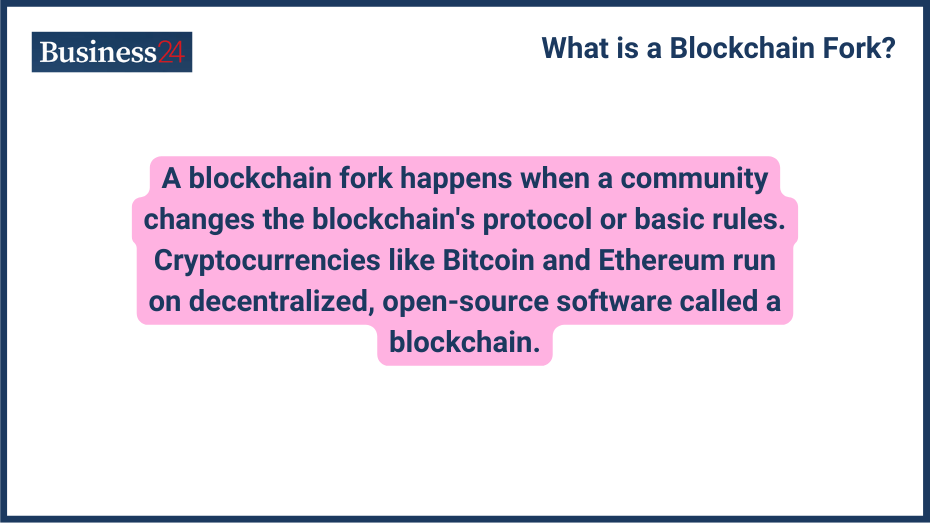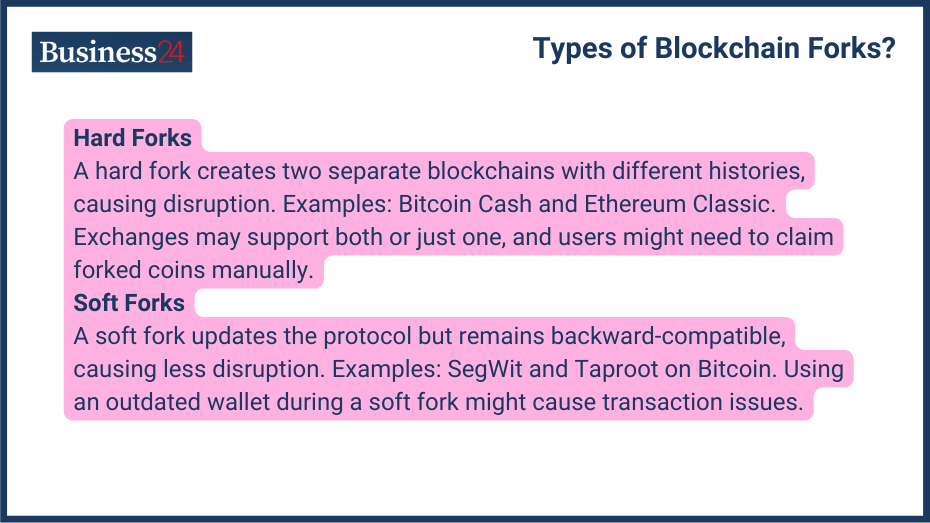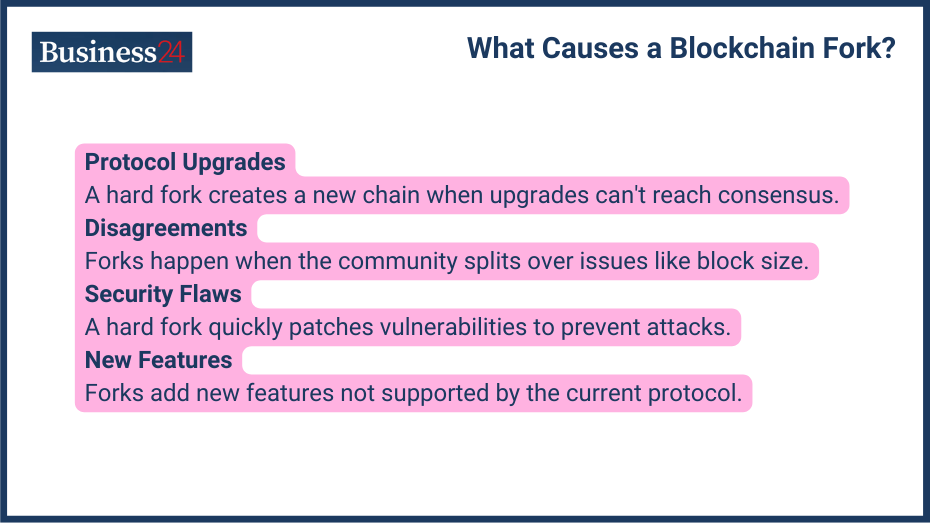
A blockchain fork happens when a community changes the blockchain’s protocol or basic rules. Cryptocurrencies like Bitcoin and Ethereum run on decentralized, open-source software called a blockchain.
Blockchain has brought many new technologies and use cases of cryptos in the financial landscape. Continuously, there are a lot of changes happening in every network; a change in a blockchain protocol or basic set of rules made by the community is known as a blockchain fork. It can result in minor changes or can split the blockchain into two.
Blockchain got its name because it comprises blocks in a long chain. These blocks can be traced all the way back to the first-ever transaction on the network. Blockchain is decentralized, so all the changes or updates are made by the community. Whenever the fork of a blockchain happens, the chain splits and produces a second blockchain that shares all of its history with the original but is headed off in a new direction.
What is the Definition of a Blockchain Fork?
In simple terms, the Blockchain fork is splitting a blockchain into two networks. It is basically copying the code and modifying it to create a new software or product. For example, a single lane on a highway represents the blockchain. A fork occurs when the highway splits into two lanes, with each lane continuing the blockchain ledger but with potentially different rules or protocols.
One example of the reason for a blockchain fork is when the community faces disagreements or wants changes. This split occurs because some members adopt new rules while others stick to the original ones. As a result, two separate blockchains form, each with its own transaction history.
The specific mechanics of a fork depend on the type of fork and the underlying blockchain protocol. There are two types of blockchain forks, which we will discuss in detail later.
Why do blockchain forks happen?
Forks are not inherently negative occurrences within the blockchain ecosystem. They can be driven by various factors, some positive and some posing challenges. There are several reasons for blockchain forks, like Protocol Upgrades, disagreements in the Community, Security Vulnerabilities, and Introduction of New Features.
What are the Types of Blockchain Forks?

Mainly, there are two types of Blockchain forks with distinct characteristics and implications:
Hard Forks
A hard fork is a permanent divergence in the blockchain, resulting in the creation of two separate blockchains with their own independent transaction histories. Miners on the new chain no longer recognize the blocks on the original chain, and vice versa.
This can be disruptive and lead to confusion, as users might need to choose which chain to support. Examples of hard forks include Bitcoin Cash, forked from Bitcoin, and Ethereum Classic, forked from Ethereum.
Exchanges may support chains or only one, and users might need to take manual steps to claim their forked coins.
Soft Forks
In blockchain technology, a soft fork changes the software protocol so that some previously valid transaction blocks become invalid. However, since old nodes still recognize the new blocks as valid, a soft fork remains backward-compatible.
Soft forks are generally less disruptive than hard forks as they allow for a smoother transition to the new protocol. Examples of soft forks include SegWit (implemented on the Bitcoin blockchain) and Taproot (implemented on the blockchain).
If you’re using an outdated wallet that hasn’t been updated to recognize the soft fork, you might experience difficulties sending or receiving transactions on the upgraded network.
What happens to my crypto in a fork?
So, depending on the type of fork used on the blockchain, there will be different results for your crypto. If the protocol change is significant enough, it can lead to the creation of a new blockchain plus a new coin known as a hard fork. The value of these forked coins can be highly volatile and uncertain, and users might need to take manual steps to claim them.
In a soft fork, your crypto remains unaffected. The blockchain continues to function as usual, with some changes in the protocol. Old nodes still recognize the new blocks, so your transactions and balances stay intact.
What is a fork swap in crypto?
While the term fork swap is not used regularly, it generally refers to exchanging your cryptocurrency from the original chain for new coins on a newly created chain after a hard fork. This usually means claiming your new coins from the forked chain and possibly converting them into a tradable form on an exchange.
Depending on how the hard fork is implemented, you might need to take specific actions to claim your new coins on the forked chain. You can use a special tool provided by the developers of the forked chain or interact with your wallet in a specific way.
What Causes a Blockchain Fork?

As I have said earlier, there are various reasons for blockchain fork, which includes:
- Protocol Upgrades: To resolve network issues like scalability issues and enhance security, a blockchain fork is done. If the community cannot reach a consensus on the proposed changes, a hard fork might be necessary to implement the upgrade on a separate chain.
- Disagreements in the Community: Blockchain communities are decentralized and include diverse stakeholders with different interests and priorities. When members disagree about the blockchain’s future, such as changes to block size, mining difficulty, or governance mechanisms, a fork can happen. Each group might support its own set of rules, leading to the creation of separate chains.
- Security Vulnerabilities: if there is a security flaw in a blockchain protocol, it might result in attacks and thefts. In such cases, a hard fork might be the quickest and most effective way to patch the vulnerability and prevent further attacks. The new chain would incorporate the necessary security fix, while the original vulnerable chain would continue.
- Introduction of New Features: A fork can happen when there’s a need to add new features that don’t fit with the existing protocol. For example, if developers want to introduce smart contracts to a blockchain that doesn’t support them, they might need to create a hard fork to start a new chain with those capabilities.
What are the Key Differences Between Hard and Soft Forks?
The simplest differentiation between a hard fork and a soft fork is that in a soft fork, previous transactions are made invalid, and a soft fork is backward compatible. Soft forks typically introduce minor changes or bug fixes. A hard fork is a permanent change in the network by splitting the blockchain into two, creating two separate chains with their own independent transaction histories.
Hard forks can be disruptive and lead to confusion within the community. Users might need to choose which chain to support, and the value of existing tokens can be affected. Soft forks are generally less disruptive as they maintain compatibility with the existing chain.
One of the major examples is Bitcoin Cash forked from Bitcoin. In 2017, the Bitcoin community disagreed over block size limits. Some members wanted larger blocks to improve scalability, so they proposed a hard fork. This led to the creation of Bitcoin Cash (BCH) with a larger block size. As a result, two separate blockchains with their own characteristics and communities emerged.
One example of a soft fork is Taprooton, the Bitcoin blockchain that introduced new functionalities for enhanced privacy and smart contract capabilities. It was done to introduce new features without causing a permanent split in the network.
What is the Process of Implementing a Fork?
Process of implementing a fork:
- Proposal and Discussion: The reason for the fork is outlined here, and the discussion for the change and technical details are laid out and analyzed in how it will impact the network. This proposal is then discussed within the community, allowing for feedback and debate.
- Coding and Testing: Coding is the most important part of all because on the future of the network will depend. After the discussion, if the community agrees on the fork proposal, developers will start coding the new protocol for the forked chain. They will then rigorously test it to ensure the new chain works correctly and has no critical vulnerabilities.
- Activation and Deployment: Once coding and testing are complete, a specific activation mechanism is defined to trigger the fork at a predetermined block height. This ensures a smooth transition for miners and users prepared for the change.
- Community Consensus and Support: The success of a hard fork depends on broad community support. Widespread adoption by miners, exchanges, and wallet providers is essential for the new chain to become viable and gain traction.
What are the Benefits of Blockchain Forks?
Again, the benefits of the blockchain fork depend on the reason the blockchain fork is done. If the reason is disagreement, it may have negative effects. But there are various benefits of the fork:
- Improvement of Blockchain Protocols: The best benefit of the blockchain fork is the improvements in the blockchain network. There are many bugs and security issues on the blockchain which can be improved by forking.
- Resolution of Disputes: Another big reason for blockchain forks is community disagreement. Generally, disagreement leads to the hard fork of the blockchain. Forks help resolve disagreements in a blockchain community by letting each group follow its rules on separate chains. This way, they avoid gridlock and can innovate independently on their respective chains.
- Enhancement of Security: Security vulnerabilities can be addressed quickly and effectively through hard forks. By creating a new, secure chain, forks can mitigate the risks associated with exploiting vulnerabilities on the original chain.
- Facilitation of Innovation and Development: Forks can pave the way for innovation and experimentation within the blockchain space. New features and functionalities can be implemented on forked chains without disrupting the established protocol on the original chain.
What are the Risks and Challenges of Blockchain Forks?
Risk and challenges of blockchain forks:
- Potential for Network Splits: Bitcoin and Bitcoin Cash are examples of network splits.
Forks can create competing blockchains, splitting the community and user base. This fragmentation weakens the network’s overall effect and makes it harder for either chain to achieve widespread adoption.
- Community Division: The main part of any blockchain network is the community, and a hard fork in crypto can divide the community into two parts, weakening the network. The decision to support one chain over another can lead to heated debates and ultimately hinder collaboration and innovation.
- Technical and Security Risks: Implementing a hard fork is a complex and technical job. It can introduce new bugs or vulnerabilities, risking the security and stability of the whole network. To mitigate these risks, thorough testing and active community involvement are crucial.
- Market and Economic Impact: Forks can create uncertainty and volatility in cryptocurrency. The value of existing tokens can fluctuate significantly depending on which chain gains wider adoption and support. Investors must carefully evaluate the risks involved before making investment decisions related to forks.
What are the Famous Examples of Blockchain Forks?
We have already discussed the two important examples: Bitcoin and Bitcoin Cash and Ethereum and Ethereum Classic. Other examples are:
First Major Hard Forks Of Bitcoin
Bitcoin XT was one of the first major hard forks of Bitcoin. Mike Hearn launched the software in late 2014 to introduce several new features he had proposed. The original Bitcoin could handle up to seven transactions per second, but Bitcoin XT aimed for 24 transactions per second. To achieve this, it proposed increasing the block size from one megabyte to eight megabytes.
Litecoin and SegWit
Another Example is Litecoin and SegWit; while not a hard fork itself, Litecoin’s adoption of SegWit in 2017 is an example of a successful soft fork implementation. Litecoin, a derivative of Bitcoin, benefited from the scalability improvements introduced by SegWit without experiencing a permanent split in the network. This demonstrates the potential for soft forks to enhance existing blockchains without disrupting the ecosystem.
How to Handle Forks as an Investor?
- Understanding Fork Announcements: Forks are very important for investors because they can change the investment idea or other aspects. I closely follow announcements and discussions within the blockchain communities in which I’m invested. As an investor, you should pay attention to proposals for forks and the potential impact on the value of your holdings.
- Managing Forked Assets: Some exchanges automatically credit your account with new coins from a hard fork. However, you should research the process and any steps you need to take to claim or manage your forked coins.
- Assessing the Impact on Investment: As I said, a fork can change the idea of why you are invested in a network, so it is important that you thoroughly analyze the impact of the fork in a blockchain. You must know its technical strengths, community support, and overall market sentiment before making any investment decisions.
- Staying Informed and Prepared: Keep yourself updated on the latest developments in the blockchain space, including ongoing discussions about potential forks. This allows you to make informed investment decisions and navigate the ever-evolving landscape of cryptocurrencies.
What are the Future Trends in Blockchain Forks?
As blockchains continue to evolve and new challenges emerge, proposals for forks to address various issues can be expected. You must track all the updates on a fork. Also, new mechanisms for implementing forks with minimal disruption or community division might be developed, which would be good for the network. Crypto space is uncertain and is expected to grow continuously. Future forks can be more advanced, benefitting the blockchain protocol, but bad moves can damage the quality of a network, too.
FAQs
Q: What is a crypto forking app?
There isn’t a “crypto forking app.” Forks are implemented by developers within the specific blockchain protocol, not through external applications. However, some wallet providers or exchanges might offer functionalities to manage or claim forked coins.
Q: Soft fork in blockchain vs hard fork in blockchain?
The key difference lies in backward compatibility. Soft forks are backward compatible, meaning miners who haven’t upgraded can still validate blocks on the original chain. Hard forks are not backward compatible, creating a permanent split in the blockchain.
Q: What are the risks of a hard fork?
The risks of a hard fork include network splits, community division, technical and security vulnerabilities, and market and economic impacts. These risks are elaborated on in the “What are the Risks and Challenges of Blockchain Forks?” section.
Q: Can a fork destroy a cryptocurrency?
A fork itself doesn’t necessarily destroy a cryptocurrency. However, the consequences of a fork, such as a network split or a loss of community confidence, can potentially harm the value and future prospects of a cryptocurrency.
Q: How do I know if a fork is good or bad?
There’s no easy answer to this question. The potential impact of a fork depends on various factors, including the purpose of the fork, the level of community support, and the technical execution. Carefully evaluating these factors and staying informed about the development process can help you form your own opinion on whether a fork is likely to be beneficial or detrimental.
Some myths about Blockchain fork:
Myth: All forks are bad for cryptocurrencies. (**Reality:** Forks can be a necessary tool for improvement, but they must be implemented carefully.)
Myth: Forks are always planned events. (**Reality:** Sometimes emergency forks might be required to address critical security vulnerabilities.)
Myth: Forks are easy to implement. (**Reality:** Implementing a successful fork, especially a hard fork, is a complex technical and social undertaking.)
Disclaimer
eToro is a multi-asset platform which offers both investing in stocks and cryptoassets, as well as trading CFDs.
Please note that CFDs are complex instruments and come with a high risk of losing money rapidly due to leverage. 61% of retail investor accounts lose money when trading CFDs with this provider. You should consider whether you understand how CFDs work, and whether you can afford to take the high risk of losing your money
This communication is intended for information and educational purposes only and should not be considered investment advice or investment recommendation. Past performance is not an indication of future results.
Copy Trading does not amount to investment advice. The value of your investments may go up or down. Your capital is at risk.
Crypto assets are complex and carry a high risk of volatility and loss. Trading or investing in crypto assets may not be suitable for all investors. Take 2 mins to learn more
eToro USA LLC does not offer CFDs and makes no representation and assumes no liability as to the accuracy or completeness of the content of this publication, which has been prepared by our partner utilizing publicly available non-entity specific information about eToro.
